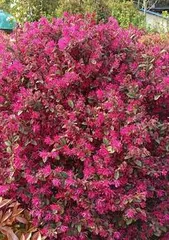Loropetalum is a common ornamental plant. Due to its many varieties and diverse forms, it often becomes a standout in landscaping. However, for many people who are new to it, how to care for Loropetalum can be a question. This article will provide a comprehensive introduction from the basic overview to key care points to help you better understand and protect this beautiful plant.

I: What is Loropetalum?
Loropetalum, also known as Chinese fringe flower, torch tree, crape myrtle, or lala tree, is a deciduous tree belonging to the Lythraceae family. This tree has a beautiful form, lush branches and leaves, and produces stunningly colorful flowers, making it a common ornamental species in gardens.
II: Varieties of Loropetalum
Common varieties of Loropetalum available on the market include Japanese torch tree, Hong Kong crape myrtle, and Seven Star crape myrtle. These varieties differ in form and flower color, and selection should be based on personal preference and landscape design needs.

III: Growing Environment for Loropetalum
Loropetalum thrives in warm, humid environments with plenty of sunlight and well-drained soil. It can also tolerate some drought and lower temperatures.
IV: Planting Methods for Loropetalum
Selecting suitable soil, choosing the right location, digging a proper hole, adding soil and fertilizer, transplanting saplings, and ensuring the sapling's healthy growth are basic steps in planting Loropetalum. At the same time, it is important to avoid damaging the roots and ensuring the foundation is stable.
V: Watering Methods for Loropetalum
During the growth of Loropetalum, different growth stages require different amounts and frequencies of watering. Generally, watering should be increased during dry seasons, but overwatering should be avoided to prevent problems like root rot.

VI: Fertilizing Methods for Loropetalum
Loropetalum is generally fertilized during the growing season (spring and autumn), but a specific fertilization plan should be made according to the variety and growth condition. Also, pay attention to the timing and concentration of fertilization.
VII: Pruning Methods for Loropetalum
Proper pruning is necessary during the growth of Loropetalum to promote lush foliage and abundant blooms. When pruning, it is important to pay attention to the location, method, and timing to avoid harming the tree.
VIII: Pest and Disease Control for Loropetalum
Loropetalum can also be threatened by some pests and diseases during its growth, such as aphids, spider mites, and powdery mildew. Preventing and treating these pests and diseases requires correct methods and chemicals, while also paying attention to the safety and environmental friendliness of the control methods.
IX: Adaptability of Loropetalum
Loropetalum has strong adaptability and can grow in different soil types and climatic conditions. When planting, it is necessary to consider the adaptability differences of different varieties to ensure the optimal landscaping effect.
X: Pairing and Application of Loropetalum
Loropetalum can be paired with other plants to create different garden styles and landscape effects. In specific applications, it is necessary to select materials and design based on elements such as site, function, and aesthetics.
XI: Artistic Expression of Loropetalum
Loropetalum is not just a garden plant, but also a form of artistic expression. Through proper planting, pruning, and management, different forms and colors of Loropetalum art can be created.
XII: Significance of Protecting Loropetalum
Loropetalum is an important ecological resource and a vital component of urban greening. Its protection and management require a focus on scientific principles, sustainability, and environmental friendliness.
XIII: Cultural Connotations of Loropetalum
Loropetalum has profound cultural connotations in traditional Chinese culture, known as the 'tree of the dedicated' or 'tree of heroes.' In modern society, it is also necessary to re-understand and explore its cultural value.
XIV: Key Care Points for Loropetalum
Caring for Loropetalum involves attention to multiple aspects such as soil, water, light, fertilization, and pruning. At the same time, targeted care is also needed according to the variety and environmental conditions.
XV: The Key to a Beautiful Garden: Cultivation and Management of Loropetalum
Loropetalum is an important part of landscaping. By understanding and mastering its care methods and key points, a more beautiful and healthy garden environment can be created.